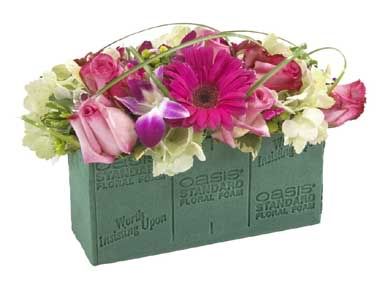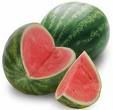Of the many challenges floral design firms face in making steps towards environmental sustainability, floral foam's inability to biodegrade is a major hurdle that needs to be overcome. For those of you who are unfamiliar with floral foam, its that green, spongy stuff that we stick flowers into. And its a ton of fun to squish with your fingers. Here's a picture that I borrowed off of the Oasis Floral Foam website just in case you need a visual.

This product is a key component is creating great design. The floral foam allows us to make arrangements in ways that is not possible in a conventional vase or container while keeping the flowers well hydrated. So, it was very disheartening for me when I learned that it is made of plastic and is not biodegradable. My thoughts went right back to waste-land...or should I say waste-island...sitting in the middle of our ocean.
So, what are my options? I've searched for biodegradable foam but it has not been developed yet. If you're reading this and you have the means to invent it, do it. You'll be rich and I'll buy from you. Actually, I found one company all the out in the UK called Val Spicer but it seems they aren't serving the US yet and the product selection is very limited. Give it more time, I'm sure I'll eventually be able to have access to this revolutionary product.
In the meantime, we've come up with a solution that we are testing right now. Want to know what it is? Okay, fine. I'll tell you.
Watermelon.

Yep, watermelon. It is the closest natural ingredient that is similar to the texture of floral foam - porous enough to insert floral stems and wet enough to keep the thirsty flowers happy.
I'll keep you posted on the results of this watermelon-foam.
If it passes all the tests, we'll be making the switch from floral foam to fruit.

This product is a key component is creating great design. The floral foam allows us to make arrangements in ways that is not possible in a conventional vase or container while keeping the flowers well hydrated. So, it was very disheartening for me when I learned that it is made of plastic and is not biodegradable. My thoughts went right back to waste-land...or should I say waste-island...sitting in the middle of our ocean.
So, what are my options? I've searched for biodegradable foam but it has not been developed yet. If you're reading this and you have the means to invent it, do it. You'll be rich and I'll buy from you. Actually, I found one company all the out in the UK called Val Spicer but it seems they aren't serving the US yet and the product selection is very limited. Give it more time, I'm sure I'll eventually be able to have access to this revolutionary product.
In the meantime, we've come up with a solution that we are testing right now. Want to know what it is? Okay, fine. I'll tell you.
Watermelon.

Yep, watermelon. It is the closest natural ingredient that is similar to the texture of floral foam - porous enough to insert floral stems and wet enough to keep the thirsty flowers happy.
I'll keep you posted on the results of this watermelon-foam.
If it passes all the tests, we'll be making the switch from floral foam to fruit.
.jpg)






7 comments:
Hello! How is that watermelon experiment working out? Curious because the texture and liquid would seem great but I read somewhere that fruits and veggies do not do well for flowers...they omit a certain gas that shortens the life of (cut) florals... maybe not all? Please tell us more! :)
Hi there! Its so funny you posted this comment just now because I am in the middle of putting together answers to the main questions I've been getting about the watermelon. That post will be up very soon so be sure to check back! But I do recommend using the watermelon with great caution because its not practical for all purposes. You're right about gas that fruits and veggies omit - called ethylene, the ripening agent - which causes fresh cut flowers to decay faster. In short, watermelon 'floral foam' is cut open fruit which doesn't do well out in the open. So, I recommend using it for day events in an air conditioned setting and it must be broken down immediately after the event is over. Thanks for keeping the conversation going!!
bravo on your search!
i am going through the same strife as a floral designer...
let's keep in touch if either of us discovers a solution.
best,
lisa @ pot & box
ann arbor, michigan
Thanks Lisa! I am so excited to know that other floral designers are on an active search too! Please keep in touch and let me know if you find any great sustainable alternatives to floral foam. -Joanna
I would love to know the answer as I avoid florist foam too. Keep us posted if you find out any more.
Hi Andrea!
Thanks for stopping by! I'll be posting shortly on a sustainable event I just did in which no floral foam was used. Keep an eye for that!
Joanna
Hello, I am Rina from Indonesia. We use banana trunk for floral - well, the cut of middle part of banana tree. Obviously it is very easy to find in any part of the country, but for those who lives in the cold climate countries, I don't know yet what the alternative would be. The texture is amazingly great and it does contain water so it keeps flower last longer. It is a waste product too as when one harvested the banana, the tree has to be cut to allow the new 'baby trees' to grow. So, in that sense, it is cheaper in cost! Do visit any local florist when you go to Indonesia, you'll find them used widely!
Post a Comment